An Experimental and Simulation Study for Comparison of the Sensitivity of Different Non-Destructive Capacitive Sensors in a Stratified Two-Phase Flow Regime
Abstract
:1. Introduction
2. Experimental Setup
2.1. Double-Ring Configuration
2.2. Concave Configuration
3. Numerical Simulations
3.1. Double-Ring Configuration
3.2. Concave Configuration
4. Results and Discussions
5. Conclusions
Author Contributions
Funding
Data Availability Statement
Conflicts of Interest
References
- Ahmed, H. Capacitance sensors for void-fraction measurements and flow-pattern identification in air–oil two-phase flow. IEEE Sens. J. 2006, 6, 1153–1163. [Google Scholar] [CrossRef]
- Steven, R.N. Wet gas metering with a horizontally mounted Venturi meter. Flow Meas. Instrum. 2002, 12, 361–372. [Google Scholar] [CrossRef]
- Yang, H.C.; Kim, D.K.; Kim, M.H. Void fraction measurement using impedance method. Flow Meas. Instrum. 2003, 14, 151–160. [Google Scholar] [CrossRef]
- Demori, M.; Ferrari, V.; Strazza, D.; Poesio, P. A capacitive sensor system for the analysis of two-phase flows of oil and conductive water. Sens. Actuators A Phys. 2010, 163, 172–179. [Google Scholar] [CrossRef]
- Strazza, D.; Demori, M.; Ferrari, V.; Poesio, P. Capacitance sensor for hold-up measurement in high-viscous-oil/conductive-water core-annular flows. Flow Meas. Instrum. 2011, 22, 360–369. [Google Scholar] [CrossRef]
- An, Z.; Ningde, J.; Lusheng, Z.; Zhongke, G. Liquid holdup measurement in horizontal oil–water two-phase flow by using concave capacitance sensor. Measurement 2014, 49, 153–163. [Google Scholar] [CrossRef]
- Ortiz, J.; Masek, V. Cyclonic capacitive sensor for multiphase composition measurement. Sens. Transducers 2015, 191, 1. [Google Scholar]
- Zhai, L.S.; Jin, N.D.; Gao, Z.K.; Zhao, A.; Zhu, L. Cross-correlation velocity measurement of horizontal oil–water two-phase flow by using parallel–wire capacitance probe. Exp. Therm. Fluid Sci. 2014, 53, 277–289. [Google Scholar] [CrossRef]
- Zhai, L.; Jin, N.; Gao, Z.; Wang, Z. Liquid holdup measurement with double helix capacitance sensor in horizontal oil–water two-phase flow pipes. Chin. J. Chem. Eng. 2015, 23, 268–275. [Google Scholar] [CrossRef]
- Veisi, A.; Shahsavari, M.H.; Roshani, G.H.; Eftekhari-Zadeh, E.; Nazemi, E. Experimental Study of Void Fraction Measurement Using a Capacitance-Based Sensor and ANN in Two-Phase Annular Regimes for Different Fluids. Axioms 2023, 12, 66. [Google Scholar] [CrossRef]
- Salehi, S.M.; Karimi, H.; Moosavi, R.; Dastranj, A.A. Different configurations of capacitance sensor for gas/oil two phase flow measurement: An experimental and numerical study. Exp. Therm. Fluid Sci. 2017, 82, 349–358. [Google Scholar] [CrossRef]
- Abouelwafa, M.S.; Kendall, E.J. The use of capacitance sensors for phase percentage determination in multiphase pipelines. IEEE Trans. Instrum. Meas. 1980, 29, 24–27. [Google Scholar] [CrossRef]
- Jaworek, A.; Krupa, A. Gas/liquid ratio measurements by rf resonance capacitance sensor. Sens. Actuators A: Phys. 2004, 113, 133–139. [Google Scholar] [CrossRef]
- Dos Reis, E.; da Silva Cunha, D. Experimental study on different configurations of capacitive sensors for measuring the volumetric concentration in two-phase flows. Flow Meas. Instrum. 2014, 37, 127–134. [Google Scholar] [CrossRef]
- Ye, J.; Peng, L.; Wang, W.; Zhou, W. Optimization of helical capacitance sensor for void fraction measurement of gas-liquidtwo-phase flow in a small diameter tube. IEEE Sens. J. 2011, 11, 2189–2196. [Google Scholar] [CrossRef]
- Tollefsen, J.; Hammer, E.A. Capacitance sensor design for reducing errors in phase concentration measurements. Flow Meas. Instrum. 1998, 9, 25–32. [Google Scholar] [CrossRef]
- Geraets, J.J.M.; Borst, J.C. A capacitance sensor for two-phase void fraction measurement and flow pattern identification. Int. J. Multip. Flow 1988, 14, 305–320. [Google Scholar] [CrossRef]
- Elkow, K.J.; Rezkallah, K.S. Void fraction measurements in gas-liquid flows using capacitance sensors. Meas. Sci. Technol. 1996, 7, 1153. [Google Scholar] [CrossRef]
- Pal, A.; Vasuki, B. Void fraction measurement using concave capacitor based sensor–Analytical and experimental evaluation. Measurement 2018, 124, 81–90. [Google Scholar] [CrossRef]
- Andreussi, P.; Bendiksen, K. An investigation of void fraction in liquid slugs for horizontal and inclined gas—Liquid pipe flow. Int. J. Multiph. Flow 1989, 15, 937–946. [Google Scholar] [CrossRef]
- Özgü, M.R.; Chen, J.C.; Eberhardt, N. A capacitance method for measurement of film thickness in two-phase flow. Rev. Sci. Instrum. 1973, 44, 1714–1716. [Google Scholar] [CrossRef]
- Huang, S.M.; Plaskowski, A.B.; Xie, C.G.; Beck, M.S. Tomographic imaging of two-component flow using capacitance sensors. J. Phys. E Sci. Instrum. 1989, 22, 173. [Google Scholar] [CrossRef]
- Gamio, J.C.; Castro, J.; Rivera, L.; Alamilla, J.; Garcia-Nocetti, F.; Aguilar, L. Visualisation of gas–oil two-phase flows in pressurised pipes using electrical capacitance tomography. Flow Meas. Instrum. 2005, 16, 129–134. [Google Scholar] [CrossRef]
- Kendoush, A.A.; Sarkis, Z.A. Improving the accuracy of the capacitance method for void fraction measurement. Exp. Therm. Fluid Sci. 1995, 11, 321–326. [Google Scholar] [CrossRef]
- Mohamad, E.J.; Rahim, R.A.; Rahiman, M.H.; Ameran, H.L.; Muji, S.Z.; Marwah, O.M. Measurement and analysis of water/oil multiphase flow using Electrical Capacitance Tomography sensor. Flow Meas. Instrum. 2016, 47, 62–70. [Google Scholar] [CrossRef]
- Canière, H.; T’Joen, C.; Willockx, A.; De Paepe, M. Capacitance signal analysis of horizontal two-phase flow in a small diameter tube. Exp. Therm. Fluid Sci. 2008, 32, 892–904. [Google Scholar] [CrossRef]
- Roshani, M.; Phan, G.T.; Nazemi, E.; Eftekhari-Zadeh, E.; Phan, N.H.; Corniani, E.; Tran, H.N.; Duong, V.H.; Roshani, G.H. Performance comparison of capacitance-based flowmeter with gamma-ray attenuation-based two-phase flowmeter for determining volume fractions in an annular flow regime’s components. Eur. Phys. J. Plus 2021, 136, 1–2. [Google Scholar] [CrossRef]
- Hosseini, S.; Taylan, O.; Abusurrah, M.; Akilan, T.; Nazemi, E.; Eftekhari-Zadeh, E.; Bano, F.; Roshani, G.H. Application of Wavelet Feature Extraction and Artificial Neural Networks for Improving the Performance of Gas–Liquid Two-Phase Flow Meters Used in Oil and Petrochemical Industries. Polymers 2021, 13, 3647. [Google Scholar] [CrossRef]
- Taylan, O.; Abusurrah, M.; Amiri, S.; Nazemi, E.; Eftekhari-Zadeh, E.; Roshani, G.H. Proposing an Intelligent Dual-Energy Radiation-Based System for Metering Scale Layer Thickness in Oil Pipelines Containing an Annular Regime of Three-Phase Flow. Mathematics 2021, 9, 2391. [Google Scholar] [CrossRef]
- Simorangkir, R.B.; Bayat-Makou, N.; Kishk, A.A.; Esselle, K.P. Advancements and artificial intelligence approaches in antennas for environmental sensing. In Artificial Intelligence and Data Science in Environmental Sensing; Academic Press: Cambridge, MA, USA, 2022; pp. 19–38. [Google Scholar]
- Afzal, M.U.; Hayat, T.; Esselle, K.P.; Mandal, K. All-metal wideband metasurface for near-field transformation of medium-to-high gain electromagnetic sources. Sci. Rep. 2021, 11, 9421. [Google Scholar]
- Iliyasu, A.M.; Fouladinia, F.; SSalama, A.; Roshani, G.H.; Hirota, K. Intelligent Measurement of Void Fractions in Homogeneous Regime of Two Phase Flows Independent of the Liquid Phase Density Changes. Fractal Fract. 2023, 7, 179. [Google Scholar] [CrossRef]
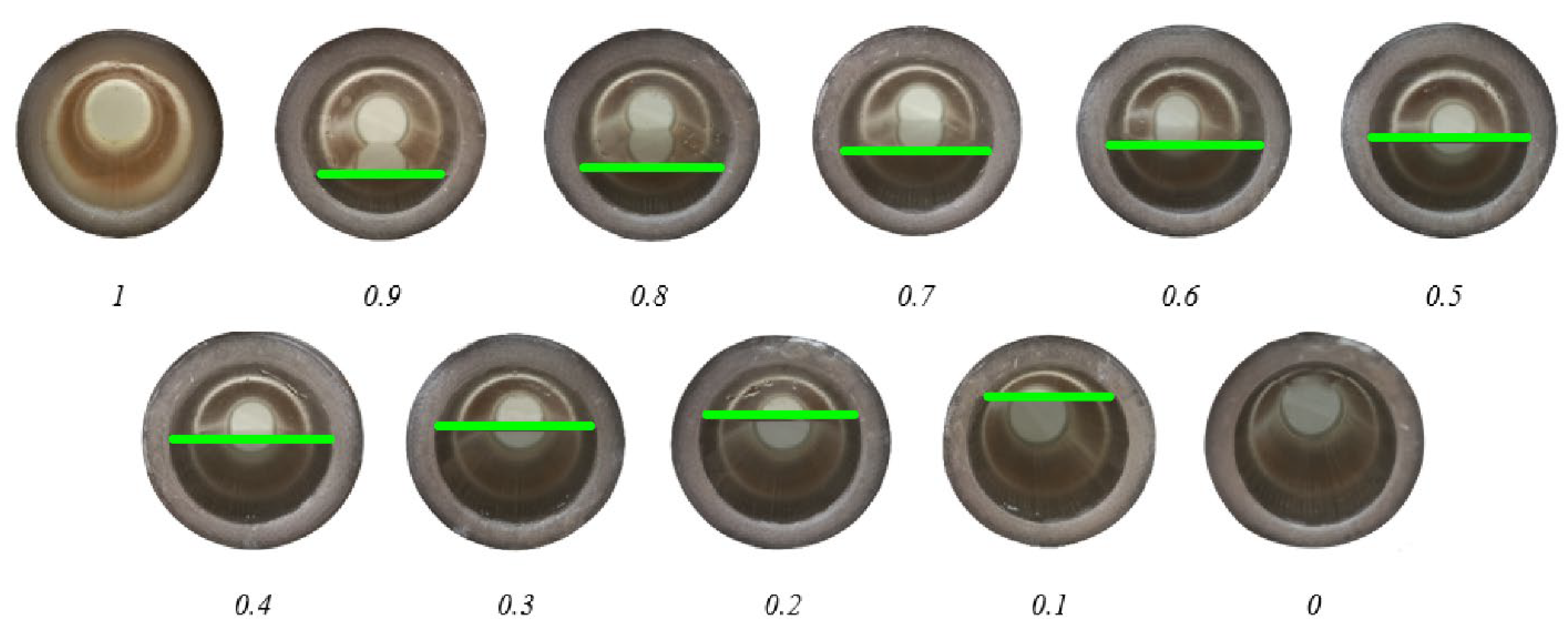
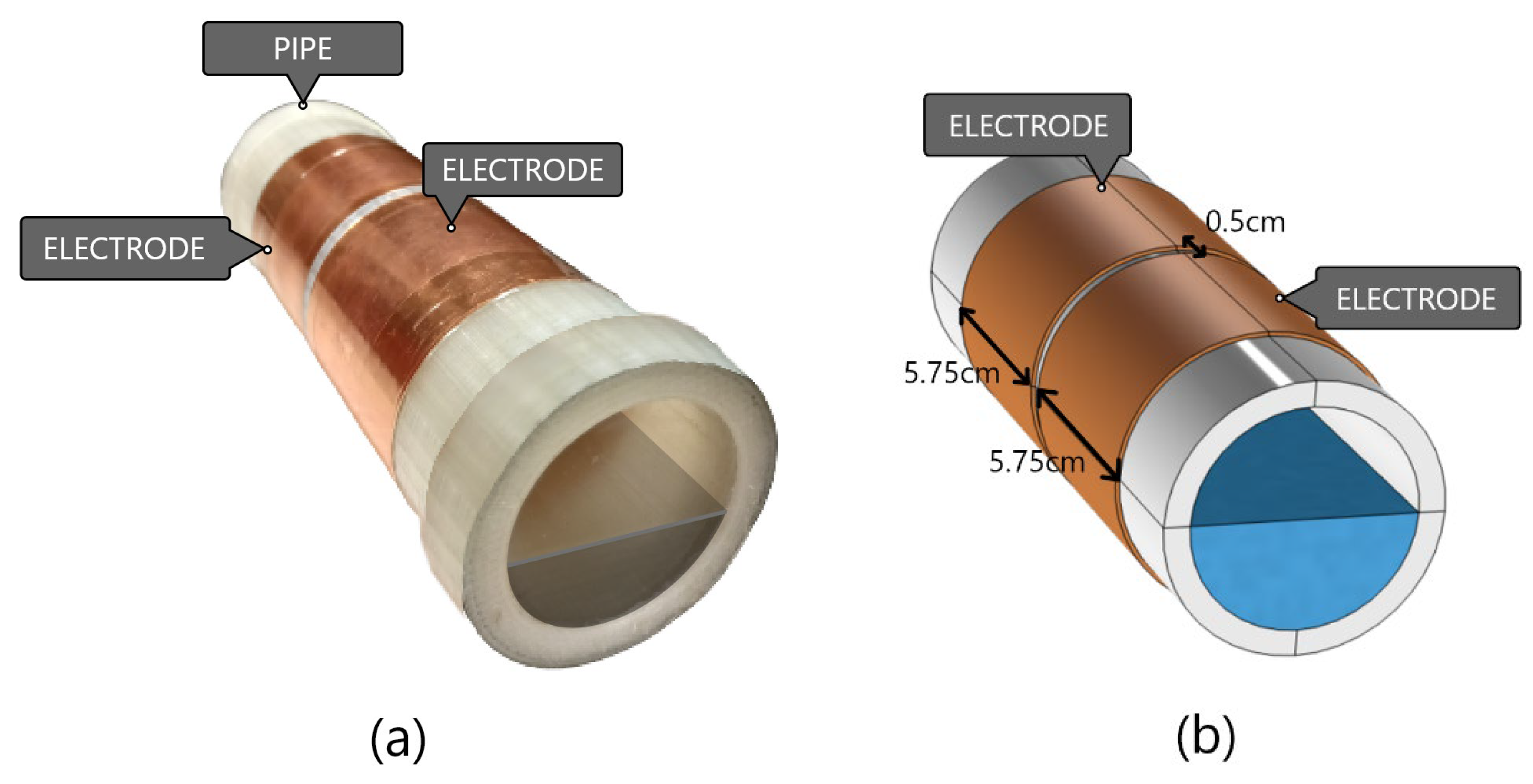

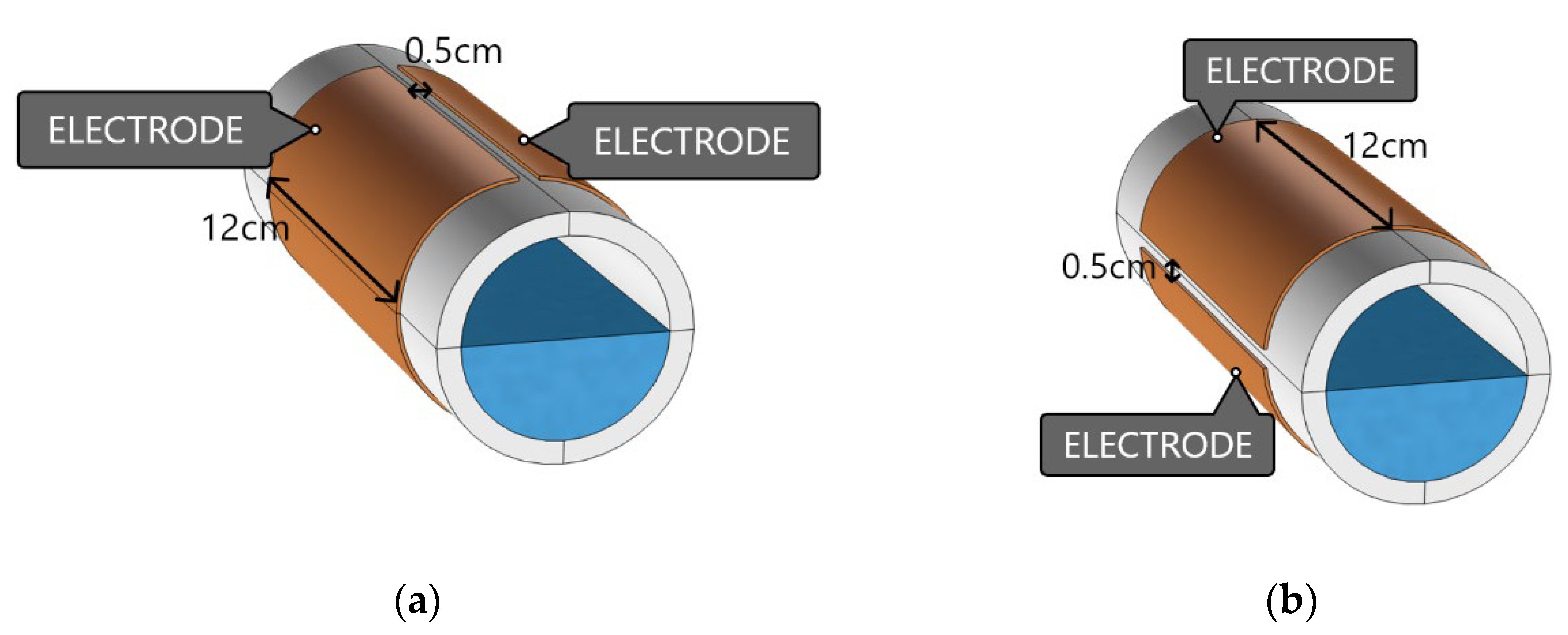
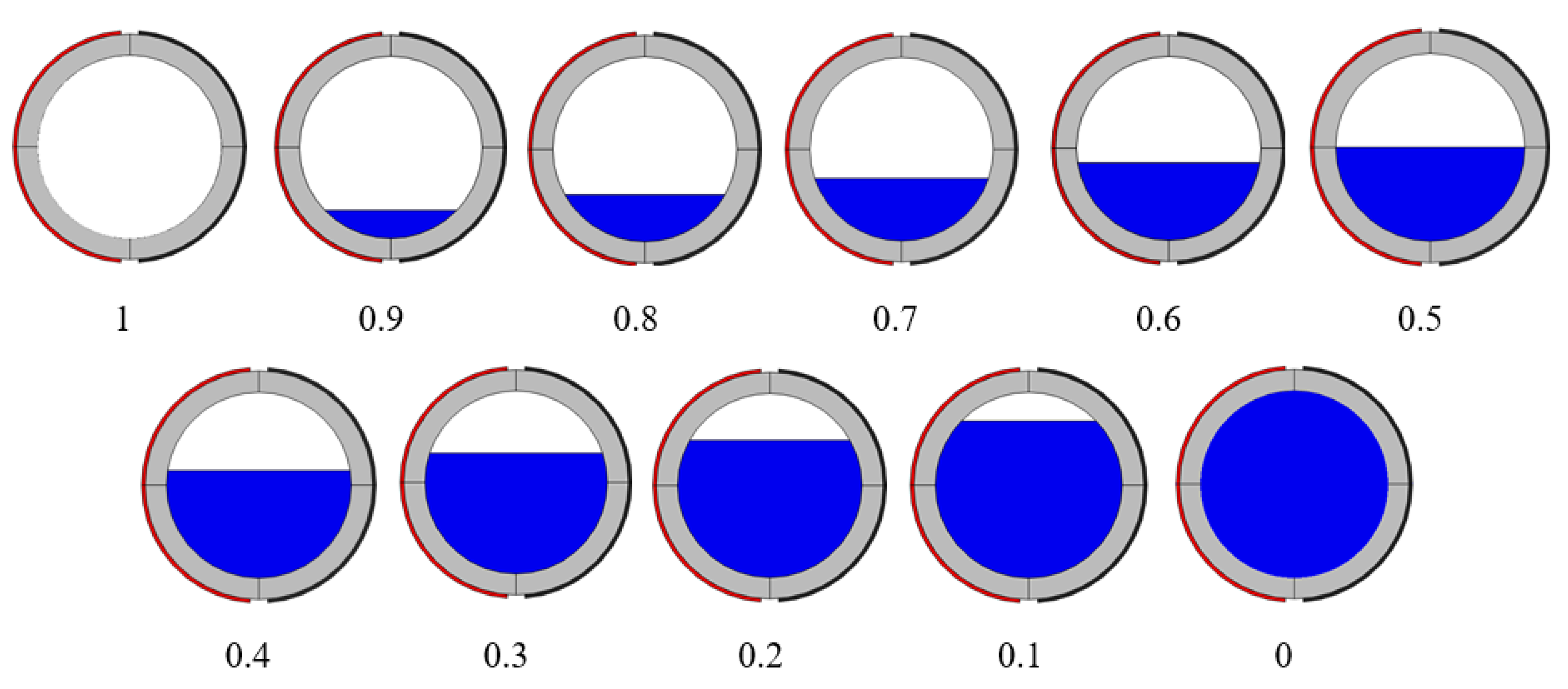




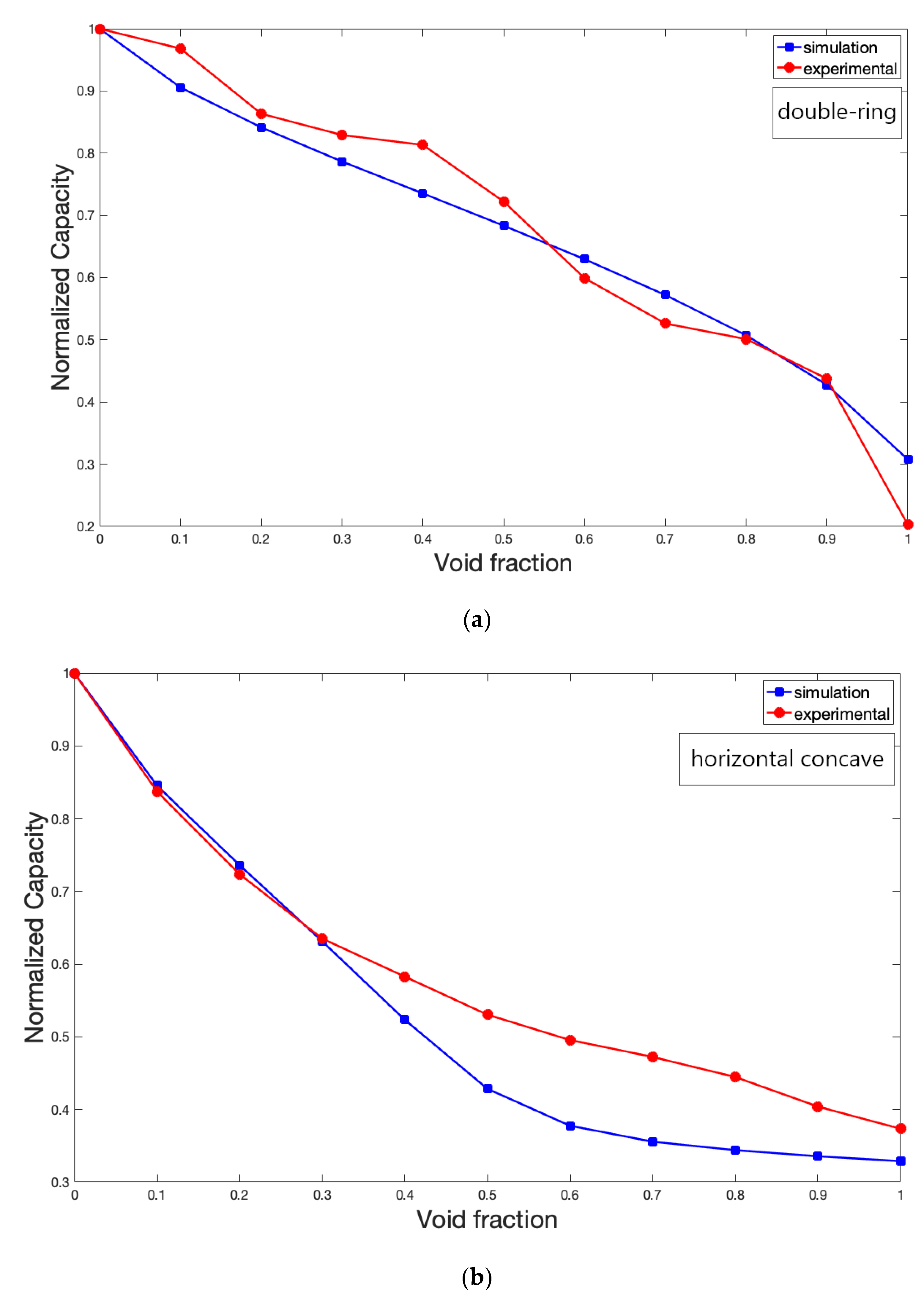

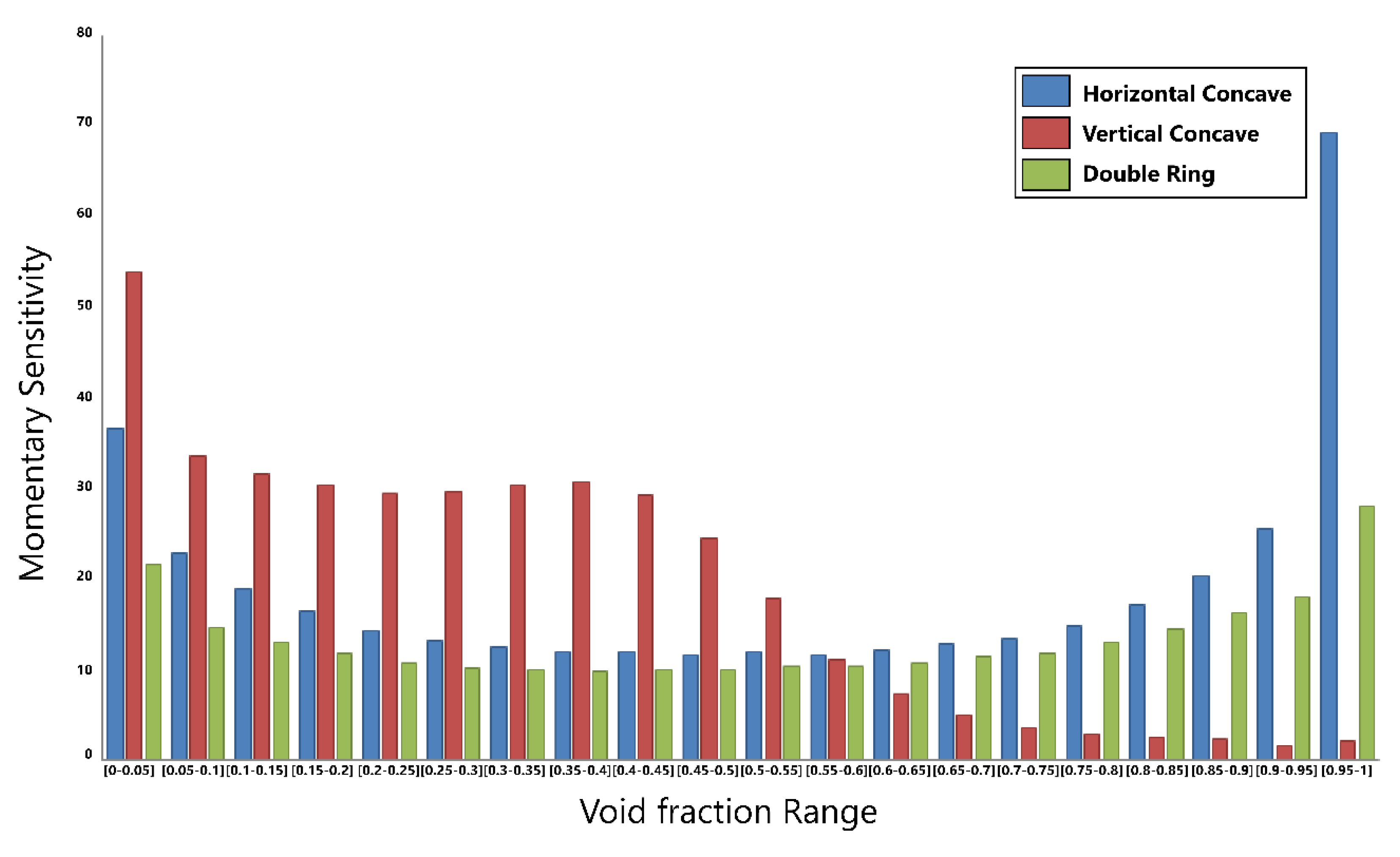
| Experimental Results | |
|---|---|
| Void Fraction | Double-Ring (pF) |
| 1 | 8.91 |
| 0.9 | 19.23 |
| 0.8 | 22.04 |
| 0.7 | 23.15 |
| 0.6 | 26.35 |
| 0.5 | 31.76 |
| 0.4 | 35.74 |
| 0.3 | 36.41 |
| 0.2 | 37.97 |
| 0.1 | 42.55 |
| 0 | 43.93 |
| Experimental Results | ||
|---|---|---|
| Void Fraction | Horizontal Concave (pF) | Vertical Concave (pF) |
| 1 | 25.32 | 25.72 |
| 0.9 | 37.91 | 27.84 |
| 0.8 | 44.92 | 30.66 |
| 0.7 | 47.85 | 32.54 |
| 0.6 | 51.87 | 34.12 |
| 0.5 | 53.65 | 36.54 |
| 0.4 | 57.43 | 40.11 |
| 0.3 | 58.02 | 43.73 |
| 0.2 | 63.31 | 49.81 |
| 0.1 | 68.27 | 57.62 |
| 0 | 68.84 | 68.84 |
| Simulation Results | |
|---|---|
| Void Fraction | Double Ring (pF) |
| 1 | 5.94 |
| 0.9 | 8.25 |
| 0.8 | 9.79 |
| 0.7 | 11.04 |
| 0.6 | 12.15 |
| 0.5 | 13.19 |
| 0.4 | 14.19 |
| 0.3 | 15.18 |
| 0.2 | 16.24 |
| 0.1 | 17.48 |
| 0 | 19.30 |
| Simulation Results | ||
|---|---|---|
| Void Fraction | Horizontal Concave (pF) | Vertical Concave (pF) |
| 1 | 9.30 | 9.31 |
| 0.9 | 14.05 | 9.50 |
| 0.8 | 15.93 | 9.74 |
| 0.7 | 17.34 | 10.07 |
| 0.6 | 18.60 | 10.69 |
| 0.5 | 19.78 | 12.14 |
| 0.4 | 20.97 | 14.83 |
| 0.3 | 22.20 | 17.86 |
| 0.2 | 23.58 | 20.85 |
| 0.1 | 25.36 | 23.95 |
| 0 | 28.34 | 28.34 |
Disclaimer/Publisher’s Note: The statements, opinions and data contained in all publications are solely those of the individual author(s) and contributor(s) and not of MDPI and/or the editor(s). MDPI and/or the editor(s) disclaim responsibility for any injury to people or property resulting from any ideas, methods, instructions or products referred to in the content. |
© 2023 by the authors. Licensee MDPI, Basel, Switzerland. This article is an open access article distributed under the terms and conditions of the Creative Commons Attribution (CC BY) license (https://creativecommons.org/licenses/by/4.0/).
Share and Cite
Shahsavari, M.H.; Veisi, A.; Roshani, G.H.; Eftekhari-Zadeh, E.; Nazemi, E. An Experimental and Simulation Study for Comparison of the Sensitivity of Different Non-Destructive Capacitive Sensors in a Stratified Two-Phase Flow Regime. Electronics 2023, 12, 1284. https://doi.org/10.3390/electronics12061284
Shahsavari MH, Veisi A, Roshani GH, Eftekhari-Zadeh E, Nazemi E. An Experimental and Simulation Study for Comparison of the Sensitivity of Different Non-Destructive Capacitive Sensors in a Stratified Two-Phase Flow Regime. Electronics. 2023; 12(6):1284. https://doi.org/10.3390/electronics12061284
Chicago/Turabian StyleShahsavari, Mohammad Hossein, Aryan Veisi, Gholam Hossein Roshani, Ehsan Eftekhari-Zadeh, and Ehsan Nazemi. 2023. "An Experimental and Simulation Study for Comparison of the Sensitivity of Different Non-Destructive Capacitive Sensors in a Stratified Two-Phase Flow Regime" Electronics 12, no. 6: 1284. https://doi.org/10.3390/electronics12061284
APA StyleShahsavari, M. H., Veisi, A., Roshani, G. H., Eftekhari-Zadeh, E., & Nazemi, E. (2023). An Experimental and Simulation Study for Comparison of the Sensitivity of Different Non-Destructive Capacitive Sensors in a Stratified Two-Phase Flow Regime. Electronics, 12(6), 1284. https://doi.org/10.3390/electronics12061284








